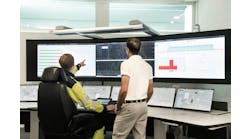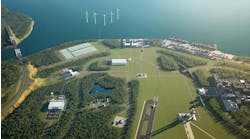Zurich, Switzerland, March 27 - One of ABBs largest orders in 2007 came from a unit of E.ON, Germany's biggest utility, for technology that will link the worlds largest offshore wind farm to the German power grid. The project is unique," said Karl-Heinz Lampe, Managing Director for E.ON Netz Offshore.
Valued at more than $400 million, it will use ABB's HVDC Light technology, a high-voltage direct current solution that enables the transmission of large amounts of power underwater and underground, with minimal impact on the environment.
"A rectifier station has never been built on its own platform in the North Sea before," Lampe said. "Besides being 130 kilometers out to sea and connecting 80 wind turbines the worlds largest offshore wind farm the station will also transmit power to a receiving station on land via undersea cables and landlines.
At present, there are no wind farms along Germanys coasts. Land-based wind power accounts for about 7 percent of the countrys electrical production, which makes Germany the leading wind-power nation in Europe. The government aims to double wind-power capacity by 2020, and a large part of the additional power is expected to come from offshore farms.
Politicians here in Germany are following the project NORD E.ON 1 with special interest, and it has also drawn considerable attention from abroad, Lampe said.
Wind-power engineering company BARD Engineering is building the wind farm in an area known as Borkum 2 one of four areas set aside for offshore wind-power clusters in the German North Sea. The 80-turbine farm is scheduled to enter service in 2009 with a combined output of 400 megawatts (MW), and Lampe believes that new wind farms in the North Sea could be producing 3,000 MW as early as 2011.
Many new development plans have emerged since a law in December 2006 that requires German grid companies to connect German wind farms as soon as they are ready to be put into service, and to bear the costs of the necessary connections. This has reduced costs for wind-power developers by 25 to 30 percent and has significantly accelerated the growth of wind farms, Lampe said.
According to Larksampe, there are now concrete plans for 20 to 25 farms in the four German North Sea wind-power clusters, known as Borkum 1 and 2, Helgoland and Sylt. Current plans will see German offshore wind farms providing a total of 12,000 MW by the year 2020.
Each of the four wind-power clusters will need a separate connection to the grid," Lampe added. "We also need to increase the grid connection capacity as early as the next cluster connection. The HVDC Light installation that will be put in service in the autumn of 2009 is rated at 400 MW, but we have to increase this quickly to between 1,400 and 1,600 MW for each cluster.
There are even plans to build German wind farms in the Baltic, for example in Kriegers Flak, near Trelleborg, an economic zone shared by Sweden, Denmark and Germany. The Swedish utility Vattenfall is also investigating the feasibility of building a 128-turbine wind farm in this area.
But for the new offshore wind power system to be developed further, national and cross-border infrastructure for power transmission must be improved to accommodate the large quantities of electrical power generated when winds are high. And when the wind is light, it must be possible to access supplemental power sources that are easy to regulate.
Power from the North Sea wind farms could be supplemented with hydropower from Norway. This is one of the reasons for a preliminary study being carried out by E.ON Netz and Norway's Statnett on a planned high-voltage link between Germany and Norway.
NorNed, a project connecting the electrical grids in Norway and the Netherlands via a 580-kilometer HVDC cable, will be put in service later this year. This will enable greater use of Norwegian hydropower and further development of wind power in Europe.
Beyond these projects, there are also plans for a super grid of undersea transmission cables that includes both links between wind parks and onshore grids, and between the countries around the North Sea. This is still a vision, but it was not that long ago that large-scale offshore wind-power production was just a vision.



